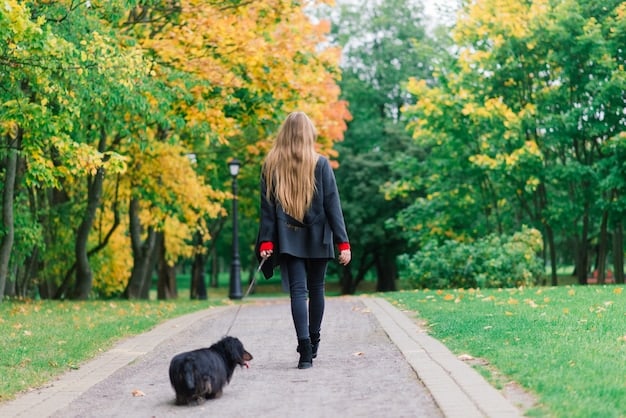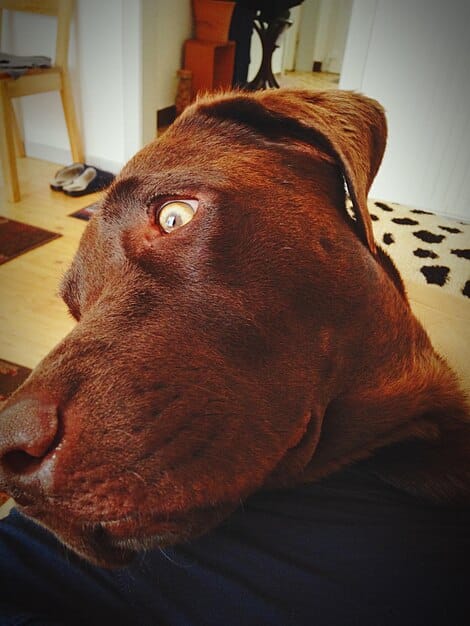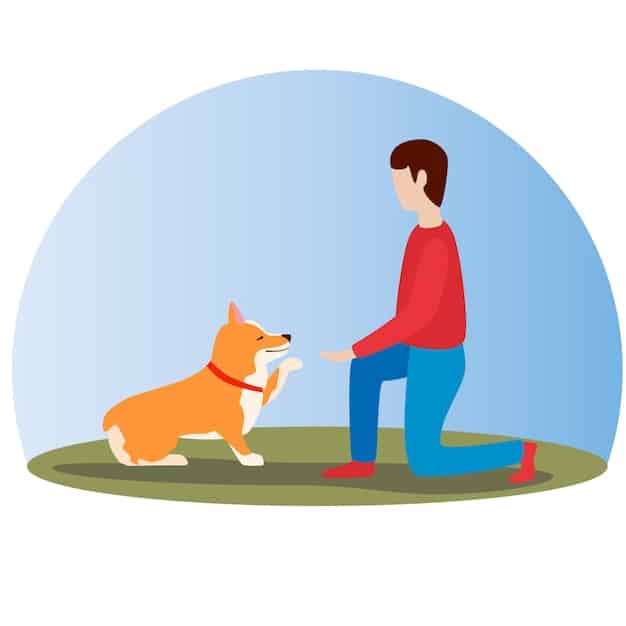Stop Stranger Danger: Behavior Modification for Aggressive Dogs in 2025

Aggression towards strangers in dogs can be a challenging issue. A 2025 behavior modification plan involves understanding triggers, desensitization, counter-conditioning, and consistent positive reinforcement to help your dog feel more secure and less threatened by unfamiliar people.
Is your dog showing signs of aggression towards strangers? You’re not alone. Many dog owners face this behavioral challenge, but with the right approach, you can create a safer and more positive environment for your furry friend and the people around them. Let’s explore a step-by-step behavior modification plan for 2025.
Understanding Aggression Towards Strangers in Dogs
Before diving into a behavior modification plan, it’s crucial to understand why your dog is displaying aggression towards strangers. It’s rarely a simple case of “bad behavior.” Often, it’s rooted in fear, anxiety, or a protective instinct.
Dogs may react aggressively to strangers due to a variety of reasons, including a lack of early socialization, negative experiences with unfamiliar people, or simply a natural inclination to guard their territory and loved ones. Understanding these potential causes is the first step in addressing the behavior.
Common Triggers for Aggression
Identifying the triggers that set off your dog’s aggression is essential for developing an effective behavior modification plan. Common triggers include:
- Approaching the dog directly.
- Making direct eye contact.
- Reaching towards the dog.
- Entering the dog’s perceived territory.
The Role of Socialization
Early socialization plays a critical role in shaping a dog’s behavior towards strangers. Dogs that are properly socialized as puppies are generally more comfortable and confident around unfamiliar people. Lack of socialization can lead to fear and anxiety, which can then manifest as aggression.
Consider your dog’s early experiences. Was your dog exposed regularly to new people, places, and situations during the critical socialization period (approximately 3 to 16 weeks of age)? If not, this could be contributing to their current behavior.

In conclusion, understanding the root causes and triggers of aggression towards strangers is vital for developing a targeted and effective behavior modification plan. By addressing the underlying fear and anxiety, you can help your dog feel more secure and less reactive in the presence of unfamiliar people.
Step 1: Management Techniques for Safety
Before starting any training, it’s paramount to implement management techniques to ensure the safety of everyone involved – your dog, yourself, and strangers. Aggression towards strangers can be dangerous, so proactive measures are necessary.
The goal of management is to prevent your dog from practicing the unwanted behavior and to minimize the risk of bites or other aggressive incidents. This involves creating a safe environment where your dog feels secure and where strangers are kept at a safe distance.
Using a Muzzle
A muzzle is a valuable tool for managing aggression towards strangers, especially during the initial stages of training. It allows you to work with your dog in a controlled environment without the fear of biting. Choose a basket muzzle that allows your dog to pant, drink, and take treats.
- Introduce the muzzle gradually using positive reinforcement.
- Pair the muzzle with positive associations, such as treats and praise.
- Never force the muzzle onto your dog.
- Ensure the muzzle fits properly and is comfortable.
Controlling the Environment
Environmental management is another vital aspect of keeping everyone safe. This involves modifying your dog’s surroundings to reduce exposure to triggers and prevent opportunities for aggression.
Keep your dog on a leash in public areas, and avoid situations where they might encounter unfamiliar people unexpectedly. Use visual barriers, such as curtains or frosted window film, to prevent your dog from reacting to people passing by your home.
To sum up, effective management techniques are crucial for ensuring safety while addressing your dog’s aggression towards strangers. By using tools like muzzles and controlling the environment, you can minimize the risk of incidents and create a safer training environment.
Step 2: Desensitization and Counter-Conditioning
Desensitization and counter-conditioning are cornerstones of behavior modification for aggression towards strangers. These techniques gradually change your dog’s emotional response to strangers from fear and aggression to calm and positive associations.
Desensitization involves exposing your dog to the trigger (strangers) at a very low intensity, below their threshold of reactivity. Counter-conditioning pairs the presence of the trigger with something positive, such as treats or praise, to create a new, positive association.
Starting with Distance
Begin by working with strangers at a distance where your dog is aware of their presence but not reacting aggressively. This distance may be quite far initially, but the goal is to gradually decrease it as your dog becomes more comfortable.
While the stranger is present, offer your dog high-value treats and provide verbal praise. The stranger should remain neutral and avoid direct eye contact or approaching the dog.
Gradual Exposure
As your dog becomes more comfortable with strangers at a distance, gradually decrease the distance over time. Monitor your dog’s body language closely and adjust the distance accordingly. Any signs of anxiety or aggression indicate that you’re moving too quickly.
- Keep sessions short and positive.
- End each session on a successful note.
- Avoid overwhelming your dog with too much exposure.
- Be patient and consistent with your training.

In conclusion, desensitization and counter-conditioning are powerful tools for changing your dog’s emotional response to strangers. By gradually exposing your dog to the trigger at a low intensity and pairing it with positive reinforcement, you can help them feel more comfortable and less reactive in the presence of unfamiliar people.
Step 3: Teaching Alternative Behaviors
Teaching your dog alternative behaviors can be a valuable addition to your aggression towards strangers modification plan. These behaviors give your dog something to do instead of reacting aggressively, providing them with a sense of control and reducing their anxiety.
The key is to choose behaviors that are incompatible with aggression, such as sitting, staying, or looking at you. These behaviors should be taught in a calm and controlled environment before being practiced in the presence of strangers.
The “Look at Me” Cue
The “look at me” cue is a particularly useful tool for redirecting your dog’s attention away from strangers. It involves teaching your dog to make eye contact with you on cue, which can help to interrupt their focus on a potential trigger and redirect their attention to you.
Start by saying “look at me” and immediately reward your dog with a treat when they make eye contact. Gradually increase the duration of eye contact and the level of distraction. Practice this cue in various environments before using it in the presence of strangers.
The “Go to Place” Cue
The “go to place” cue involves teaching your dog to go to a designated spot, such as a bed or mat, and stay there until released. This cue can be used to create distance between your dog and strangers, providing them with a safe and comfortable space to retreat to.
Start by luring your dog to the designated spot with a treat and rewarding them for staying there. Gradually increase the duration of the stay and add distractions. Practice this cue in different locations before using it in the presence of strangers.
In summary, teaching alternative behaviors provides your dog with a constructive outlet for their anxiety and helps them to manage their aggression towards strangers. By redirecting their attention and providing them with a safe space, you can empower your dog to make better choices in the presence of unfamiliar people.
Step 4: Generalization and Maintenance
Once your dog is consistently responding well to desensitization, counter-conditioning, and alternative behaviors in controlled environments, it’s time to generalize these skills to a variety of real-world situations. This involves gradually exposing your dog to strangers in different locations and under different circumstances, while continuing to reinforce positive behaviors.
Generalization is a crucial step in ensuring that your dog’s behavior modification is long-lasting and effective. It helps them to apply their newly learned skills to a variety of situations, rather than just in the training environment.
Varying the Environment
Start by practicing your training exercises in different locations, such as your yard, a quiet park, or a pet-friendly store. Gradually increase the level of distraction and the number of strangers present.
Be sure to monitor your dog’s body language closely and adjust the intensity of the environment accordingly. If they start to show signs of anxiety or aggression, take a step back and reduce the level of distraction.
Introducing Novel Strangers
As your dog becomes more comfortable and confident in different environments, begin introducing them to novel strangers. This involves having unfamiliar people approach your dog in a controlled and positive manner.
- Instruct strangers to approach slowly and calmly.
- Encourage strangers to avoid direct eye contact or reaching towards the dog.
- Have strangers offer your dog treats or verbal praise.
- Supervise all interactions closely and intervene if your dog becomes uncomfortable.
In closing, generalization and maintenance are essential for ensuring the long-term success of your aggression towards strangers behavior modification plan. By gradually exposing your dog to a variety of real-world situations and continuing to reinforce positive behaviors, you can help them to maintain their newfound skills and enjoy a more relaxed and confident life.
Step 5: Seeking Professional Guidance
While this step-by-step plan provides a comprehensive framework for addressing aggression towards strangers, it’s important to recognize that every dog is an individual and may require a tailored approach. Seeking guidance from a qualified professional can make a significant difference in the success of your efforts.
A certified professional dog trainer or behaviorist can assess your dog’s specific needs, identify underlying causes of their aggression, and develop a personalized training plan that is tailored to their unique personality and circumstances.
Consulting a Certified Dog Trainer
A certified dog trainer can provide valuable guidance and support in teaching your dog new behaviors and managing their aggression. They can help you to develop effective training techniques, troubleshoot challenges, and ensure that you are progressing safely and effectively.
- Look for a trainer who has experience working with aggressive dogs.
- Choose a trainer who uses positive reinforcement methods.
- Ask for references and check reviews.
Working with a Veterinary Behaviorist
For more complex cases of aggression towards strangers, consulting with a veterinary behaviorist may be beneficial. A veterinary behaviorist is a veterinarian who has specialized training in animal behavior and can diagnose and treat underlying medical or psychological conditions that may be contributing to your dog’s aggression.
A veterinary behaviorist can also prescribe medications, such as anti-anxiety drugs, to help manage your dog’s anxiety and make them more receptive to training.
In summary, seeking professional guidance can provide you with the expertise and support you need to effectively address your dog’s aggression towards strangers. A qualified professional can help you to identify the root causes of the behavior, develop a tailored training plan, and ensure that you are progressing safely and effectively.
| Key Point | Brief Description |
|---|---|
| 🛡️ Management | Use muzzles & control environment for safety. |
| 😌 Desensitization | Gradual exposure to strangers from a distance. |
| 🐾 Alternative Behaviors | Teach “look at me” and “go to place” commands. |
| 👨⚕️ Professional Help | Consult a trainer or veterinary behaviorist. |
Frequently Asked Questions
▼
Aggression often stems from fear, anxiety, or protective instincts. Past negative experiences or a lack of socialization can also contribute. Identifying the root cause is crucial for effective modification.
▼
Yes, when introduced properly, a muzzle can be a safe and effective tool during training. It prevents biting while allowing the dog to pant, drink, and take treats. Always choose a basket muzzle.
▼
The timeline can vary significantly depending on the dog’s temperament, the severity of the aggression, and the consistency of training. Be patient and celebrate small victories along the way.
▼
While complete elimination isn’t always possible, significant improvement is achievable. The goal is to manage the behavior and create a safer environment for the dog and those around them with consistent training.
▼
If you’re feeling overwhelmed, unsure of how to proceed, or if your dog’s aggression is severe, seek professional help from a certified trainer or veterinary behaviorist. Their expertise can be invaluable.
Conclusion
Addressing aggression towards strangers requires patience, consistency, and a commitment to understanding your dog’s needs. By implementing this step-by-step plan and seeking professional guidance, you can create a safer and more positive future for your beloved companion.





